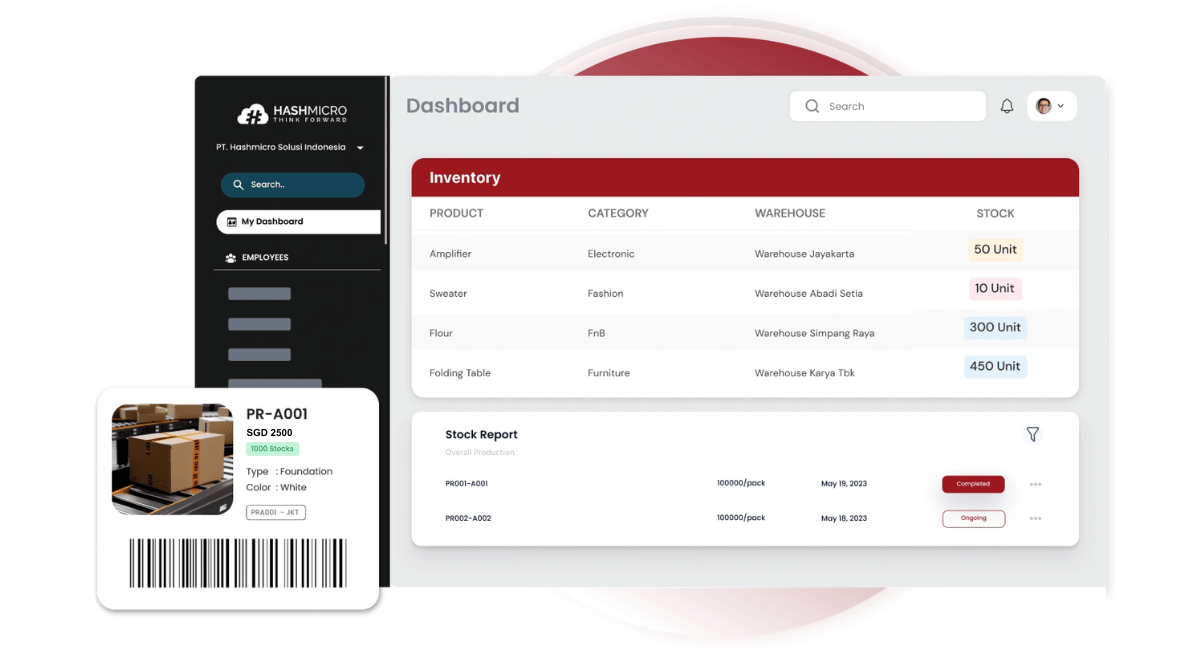Inventory aging can have significant implications for your business. It refers to stocks that have been sitting in your warehouse without moving, leading to high overhead costs, shrinking profit margins, and poor inventory control. To maintain efficient stock control and maximize profits, it is crucial to recognize and address inventory aging with inventory software.
Implementing a cloud based inventory system can further enhance efficiency by providing real-time visibility, seamless tracking, and automated reporting, ensuring better inventory management.
A recent report by the Economic Development Board of Singapore revealed that an impressive 82% of businesses in the city-state rank advanced inventory management strategies as a key factor for operational excellence. This statistic underscores a fundamental truth about doing business in Singapore: success hinges not just on what you sell, but also on how effectively you manage your resources.
In this article, we will explore the critical concept of inventory aging and its impact on businesses in Singapore. We aim to provide valuable insights into how effective inventory management, particularly in a fast-paced and highly competitive market like Singapore, is essential for maintaining a competitive edge.
Table of Content:
Table of Content
Key Takeaways
|

What is Inventory Aging?
Inventory aging is a term used to describe the length of time that stocks remain unsold in a warehouse. It is a crucial concept in inventory management as it directly impacts a company’s profitability and overall stock control. Aged inventory falls between active inventory, which is constantly replenished and sold, and dead stocks, which are items that have been sitting for an extended period without any demand.
While the ideal inventory age may vary depending on the industry, most businesses consider items that have been sitting for more than six months to be aged inventory. These products may have lost their market relevance, become obsolete, or simply failed to generate customer interest. Managing and addressing aging inventory is essential to ensure efficient stock control and reduce unnecessary costs.
Aging inventory can result in several negative consequences for businesses. It can lead to poor inventory control, inaccurate inventory balances, and a disorganized warehouse. Additionally, storing aging inventory incurs excessive storage costs as older stocks require more space and utilities. The cost of maintaining the quality of aging inventory and potential write-offs also increases, further impacting a company’s bottom line.
How Does Inventory Aging Impact Your Business?
Failing to address inventory aging can create serious challenges for your business. It often results in poor inventory control, leading to reduced productivity, inaccurate stock records, and a messy, inefficient warehouse.
When aging inventory piles up, it becomes harder to meet customer demands. This can cause missed sales opportunities and leave customers feeling frustrated and dissatisfied.
Let’s break down the key impacts of inventory aging:
| Impact Area | Key Issues | Business Consequences |
| Poor Inventory Control | Decreased productivity, inaccurate inventory balances, disorganized warehouse | Missed sales opportunities, unhappy customers |
| Excessive Storage Costs | Rising expenses for warehouse space, increased utility costs | Lower profitability, reduced capacity for business growth |
| Quality Maintenance and Inventory Write-Offs | High costs for repairs and replacements, product obsolescence or expiration | Shrinking profits, wasted resources |
If these problems aren’t tackled in time, they can take a serious toll on your bottom line. Aging inventory ties up financial resources and restricts your ability to invest in business growths.
By staying on top of your inventory management, you can prevent these issues. Taking proactive steps will help you maintain a well-organized, cost-efficient, and profitable warehouse.
Case Study: Consequences of Inventory Aging
Inventory aging can have significant consequences for businesses, as demonstrated by a real-life case study. In the case of Company X, neglecting to address aging inventory led to poor inventory control and excessive storage costs. As a result, they incurred significant inventory write-offs and struggled with a disorganized warehouse.
Without proper management, aging inventory can accumulate over time, taking up valuable space and posing financial risks. In the case of Company X, the lack of proactive measures to address inventory aging resulted in a disorganized warehouse, making it difficult to locate and manage stocks effectively. This disarray led to inefficiencies in fulfilling orders and increased the risk of product obsolescence.
By implementing effective inventory aging management practices, such as regular stock assessments and proactive measures to clear aging inventory, Company X was able to reduce costs and improve overall efficiency.
The consequences of inventory aging also extended to financial losses for Company X. Excessive storage costs were incurred due to the need for more space and utilities to accommodate aging stocks. Additionally, the company faced inventory write-offs as some items deteriorated in quality or became obsolete over time. These financial losses put a strain on profitability and hindered the company’s ability to invest in other areas of the business.
Lessons Learned:
- Proactively addressing inventory aging is crucial to maintaining efficient stock control and maximizing profits.
- Aging inventory can lead to a disorganized warehouse, decreased productivity, and increased risk of product obsolescence.
- Excessive storage costs and inventory write-offs are common consequences of neglecting to manage aging inventory effectively.
- Implementing inventory aging management practices, such as regular stock assessments and proactive measures to clear aging inventory, can reduce costs and improve overall efficiency.
How to Detect Inventory Aging: Automation
Managing inventory aging is essential for efficient stock control and maximizing profits. One of the key steps in managing inventory aging is detecting it in the first place. Manual methods, such as tracking inventory on paper or using spreadsheets, can be time-consuming and prone to errors. That’s where automation comes in.
By implementing inventory management software, businesses can streamline their inventory tracking processes and gain real-time visibility into their inventory levels. The software automatically tracks inventory movements, generates inventory aging reports, and highlights slow-moving items. This automation not only saves time but also reduces the risk of human error in tracking and managing inventory aging.
With inventory management software, you can easily identify items that have been sitting in the warehouse for an extended period, allowing you to take proactive measures to address inventory aging. This can include discounting slow-moving items, offering promotions, or reallocating resources to more profitable products. By utilizing automation for detecting inventory aging, you can optimize your inventory control and reduce holding costs.
How to Avoid Inventory Aging
- Accurate demand forecasting: It’s the key to avoiding inventory aging. By understanding customer demand patterns, you can optimize your inventory levels and avoid overstocking. Implementing demand forecasting techniques and utilizing advanced inventory management software can help you make informed decisions about inventory purchases and replenishments.
- Control inventory purchases: Segmenting your products is another effective strategy to control inventory purchases and minimize the risk of aging inventory. By categorizing your items based on their performance and demand, you can focus on the best-performing products and ensure that you have the right amount of stock for each segment. This approach allows you to allocate resources more efficiently and reduce the likelihood of excess inventory.
- Real-time inventory tracking: Regularly reviewing and analyzing your inventory data is essential in avoiding inventory aging. By monitoring sales trends, identifying slow-moving items, and adjusting your inventory strategies accordingly, you can prevent the accumulation of aging inventory. Inventory management software or warehouse management system can provide detailed reports and insights into your inventory aging, helping you make data-driven decisions and optimize your stock control.
Best Practices to Avoid Inventory Aging:
- Implement demand forecasting techniques to accurately predict customer demand.
- Segment your products based on their performance and demand.
- Regularly review and analyze your inventory data to identify slow-moving items.
- Utilize inventory management software to optimize your stock control.
By following these best practices and utilizing the right tools, you can effectively avoid inventory aging and maintain efficient stock control. This will not only help you minimize costs associated with excessive storage and inventory write-offs but also ensure that your business operates smoothly and maximizes profitability.
Benefits of Inventory Aging Report
An inventory aging report is a valuable tool for businesses looking to maximize cash flows and minimize excess stocks. By providing insights into the age of inventory, this report helps businesses make informed decisions about inventory management.
One of the main benefits of an inventory aging report is the ability to maximize cash flows. By identifying slow-moving items through the report, businesses can reallocate resources or offer discounts to free up cash. This allows for better utilization of funds and reduces the risk of having capital tied up in stagnant inventory.
Another advantage of the inventory aging report is the opportunity to minimize excess stocks. The report helps highlight products that are prone to inventory aging, allowing businesses to take proactive measures to prevent overstocking. By controlling inventory levels and avoiding excessive quantities of slow-moving items, businesses can reduce carrying costs and improve overall profitability.
Key Benefits:
- Maximizes cash flows by identifying slow-moving items
- Minimizes excess stocks by highlighting inventory aging
- Allows for better allocation of resources
- Reduces carrying costs and improves profitability
In conclusion, an inventory aging report is a powerful tool that helps businesses optimize their inventory management strategies. By leveraging the insights provided by the report, businesses can make informed decisions to maximize cash flows, minimize excess stocks, and ultimately improve their bottom line.
Inventory Software as an Inventory Aging Solution
Managing inventory aging is crucial for efficient stock control and maximizing profits. One effective solution for addressing inventory aging is the use of inventory management software. Inventory software automates the tracking of inventory movements, generates aging reports, and optimizes inventory strategies. By utilizing this software, businesses can streamline their inventory management processes, minimize inventory aging, and improve overall efficiency.
With inventory management software, you can accurately monitor the age of your inventory in real-time. This real-time visibility allows you to identify slow-moving items and take proactive measures to prevent excessive inventory aging. By staying informed about the age of your inventory, you can make informed decisions about your purchasing strategies and avoid overstocking.
Furthermore, HashMicro inventory software offers advanced features such as automated demand forecasting. This forecasting capability enables you to accurately predict customer demand and adjust your inventory levels accordingly. By aligning your inventory with actual demand, you can minimize the risk of inventory aging and reduce the associated costs.
In conclusion, implementing inventory management software as an inventory aging solution can help optimize your inventory strategies and improve stock control. By automating processes, generating inventory aging reports, and utilizing advanced features like demand forecasting, you can effectively manage inventory aging, maximize cash flows, and minimize excess stocks.
Conclusion
Efficient stock control is essential for managing inventory aging and maximizing profits. By recognizing the consequences of aging inventory and implementing the right strategies, businesses can avoid excessive costs and optimize their inventory management. Utilizing inventory management software is a valuable solution that streamlines processes, generates valuable reports, and helps optimize inventory strategies.
With inventory management software, businesses can prevent overstocking and minimize the risk of inventory aging. HashMicro offers comprehensive inventory management software with professional assistance that allows you to customize the software according to your business-specific requirements. Try the free demo now!

FAQ About Inventory Aging
-
How to manage old inventory?
Identify slow-moving items through inventory reports and clear them with discounts, bundle deals, or donations. Repurpose unsellable goods when possible. A cloud-based inventory system provides real-time visibility and automated reporting for better efficiency.
-
How can we reduce aged inventory?
Use demand forecasting and sales data analysis to avoid overstocking. Set automatic reorder points and run promotions or flash sales to move older stock quickly. Strong supplier relationships also help maintain flexible purchase terms and minimize excess inventory.
-
How do you track inventory aging?
Inventory management software offers automated aging reports and real-time tracking. These tools help categorize stock by age, identify slow-moving items, and ensure timely action to optimize stock control.




































